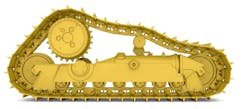Most machine owners and machine operators have heard all of this before, but the information merits repeating. Achieving maximum life from a crawler-dozer undercarriage is predicated on five fundamentals.
Selection: Undercarriage configurations available today can range from standard SALT versions to premium versions incorporating advanced technology. For most buyers, the choice hinges on which might provide the longest life, at the lowest cost per hour, in the conditions the machine is most often used. Work with the dealer when making these decisions.
Tension: One manufacturer says that tight tracks are the leading cause of warranty for crawlers and the leading cause of shortened undercarriage life. Tight tracks rob power and waste fuel; loose tracks can derail; both conditions accelerate wear. Check tension often, especially in new operating conditions, and know how to adjust in the field.
Cleanliness: Cleaning the undercarriage as often as material builds up really does extend undercarriage life—significantly. Doesn’t have to be spotless, but at least knock down the material that collects on the top of the track frames. If that material hardens or freezes overnight, especially if it’s abrasive, then it’s as if the link rails are being dragged across coarse sandpaper.
Operation: Practice operating techniques that preserve the undercarriage: Travel no faster than the application requires; limit reverse travel as much practical (three significant load points on the chain traveling in reverse, but only one traveling forward); alternate turning direction if possible; counter-rotate only when necessary; try to work up and down (not across) slopes when possible; don’t spin the tracks.
Inspection: Periodic undercarriage inspection by the dealer’s specialist is important. Most dealers use a combination of sonic and manual measurements to gauge wear, and some have software that can immediately convert measurements into percent worn. Tracking wear buys time for planning maintenance and can reveal abnormal wear, perhaps the result of poor operating habits. Telematics data can be useful for scheduling inspections on the basis of hours actually worked and might also reveal wear-accelerating conditions, such excessive reverse travel or excessive speeds.
About the Author
Walt Moore
Moore was a senior editor for Construction Equipment from 1983 through 2019.
